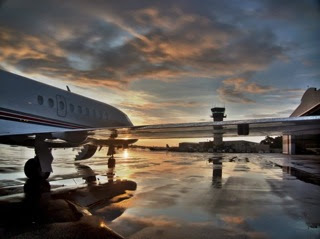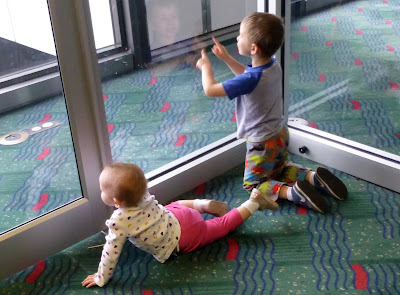As you know, I was searching for my plane... A Piper Aztec, that somehow turned into a DC3. More on that story
HERE. So during this search I was recommended by
Paul Sergeant to get a single engine engine...more specifically, a Bonanza.
Why a single engine? Why a Beechcraft?
In general, Beechcraft make the “Volvo” of the air –
solid and strong. Ypu can see that when you look at the skins and
frames in a Beechcraft – the metal skins are thicker, and the frames are
beefier. The inside is roomier, especially important for tall people.
Because
of the extra materials and wider cabin, the airplanes tend to be slower
for the given power – a Mooney goes almost as fast with a 4 cylinder
engine as the Bonanza does with a 6. But a Mooney is a metal and wooden
tube you crawl into, a Bonanza feels more like a car. The V Tail
Bonanza V35 will give a Mooney a run for the money however, due to less
wetted area and less parasitic drag.
Early
V Tails had a problem with flutter, and with the tail departing in
turbulence above Vne. So the FAA grounded the fleet in the 80’s and
introduced an AD to fix the problem. I think it is fair to say that the
V tail is one of the most studied (and now safest) light airplanes
available. But the perception remains that the V Tail is somehow
dangerous, so Beech made a version with the conventional tail, the model
33.
But the 33s and 35s have a rear CG issue, and can be easily loaded
out of limits. They are available with 3 seat rows (6 seats), but the
rear seats are really unusable, and most owners took them out (The
Cessna 210 is the same way). I have a useful load of 1,300lbs, but with
full fuel, my wife and I in the front, my two teenage girls in the
back, I can add 80 to 100lbs of baggage before running out of
arm/moment. I can’t get to the max gross unless I add 300 lbs in the
front seats J

Beechcraft
addressed the problem with the 36 series, when they moved the wing back
10”and extended the fuselage. The 36 is true 6 seater, with 2 forward
facing seats in front, and 4 “club” seats in the back, facing each other
with a little flip up card table, and large double doors.
You can put 4
reasonable sized adults in the back, 2 in the front, and still have
payload left for bags. The extra size and weight makes the 36 series
slower, so most owners want the version with a IO550 (300HP) engine.
The IO520 (285 HP) is good enough for the 33/35s. The A36 is what I
recommend for your mission.
The
A36TN is turbo-normalized, and can deliver full power up to around
17,000 ft, and cruiseswell into the flight levels. Not being
pressurized, it needs oxygen. There is no pressurized version, but
pressurization adds a lot of maintenance costs.
On
that topic, the V35 cruises at 10,000 feet at 165 kts on 12.5 gall/hr
lean-of-peak. To run LOP you need GAMI fuel injectors and a good engine
monitor. The 33 is slightly slower (perhaps 162kts) and the NA
(normally aspirated) 36 runs at about 158 kts at that fuel flow. You
can of course go faster if you are willing to run ROP instead of LOP, at
a cost of 3 or 4 gall/hr. 100LL avgas costs around $5 to 7 /gall
depending on where you buy it, so running LOP saves money.

A
single engine burns much less fuel, and requires only half the
maintenance, and the likelihood of an engine failure is cut by half. GA
twins have about the same accident rate as singles, because a twin is
2x as likely to have an engine out, and most GA pilots aren’t practiced
enough to handle a single engine emergency.
In a single, an engine
issue means you land NOW – twins often try to keep going and end up
losing control. I would only recommend a twin for someone planning to
fly over water or rugged terrain with no emergency landing places, and
for someone who doesn’t care about costs. Of course, on BeechTalk.com
any opinion about the single vs. twin engine starts an argument, since
the site is for Bonanza and Baron owner (the Barron is Bonanza with 2
engines).
My
other comment is that some Bonanzas have overly complex fuel systems
(up to 6 tanks). I deliberately chose one with 2 x 40 gallon tanks to
keep it simple – I knew someone who crashed an A36 from fuel exhaustion –
but he had fuel on board, just not in the tank he selected. My 80
gallons will last for 5.5 hours with reserves, and I only have 1 tank
selection switch. I don’t need longer in the air, my bladder range
isn’t that far! Don’t get one with multiple tanks unless you need 8 hrs
endurance – keep it simple and safe.
Many
Bonanzas have had gear up landings in the past (mine hasn’t). As long
as they’ve been properly repaired, they can be a bargain, usually about
$20k less than a no-damage history (NDH) airplane. Good use of
checklists and stabilized approach by the numbers will keep yours
undamaged. I use my gear as my speed brakes and always land at the same
power setting and speed, and unless my gear is down I can’t get that
slow. Fly it like an airliner and you’ll do great!"
There you have it...
Paul's rational of why I should buy a Beechraft A36TN.
What do you think? Do you concur with Paul, or have another suggestion? What is your experience with this airplane?
Enjoy the Journey!
XO Karlene






















































